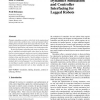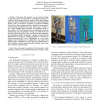35 search results - page 5 / 7 » A distributed strategy for gait adaptation in modular robots |
IJRR
2000
13 years 8 months ago
2000
Dynamics simulation can play a critical role in the engineering of robotic control code, and there exist a variety of strategies both for building physical models and for interact...
ICRA
2005
IEEE
14 years 2 months ago
2005
IEEE
- Polychaete annelid worms provide a biological paradigm of versatile locomotion and effective motion control, adaptable to a large variety of unstructured environmental conditions...
ICRA
2005
IEEE
14 years 2 months ago
2005
IEEE
— This paper first presents a novel control strategy for periodic motion control based on a Hamiltonian system. According to the strategy, hybrid symmetric orbits (ideal walking...
ALIFE
2000
13 years 8 months ago
2000
The evolution of simulated robots with three different architectures is studied in this article. We compare a nonmodular feed-forward network, a hardwired modular, and a duplicatio...
ICRA
2003
IEEE
14 years 1 months ago
2003
IEEE
— Robots typically have many sensors which are underutilized. This is usually because no simple mathematical models of the sensors have been developed or the sensors are too nois...


